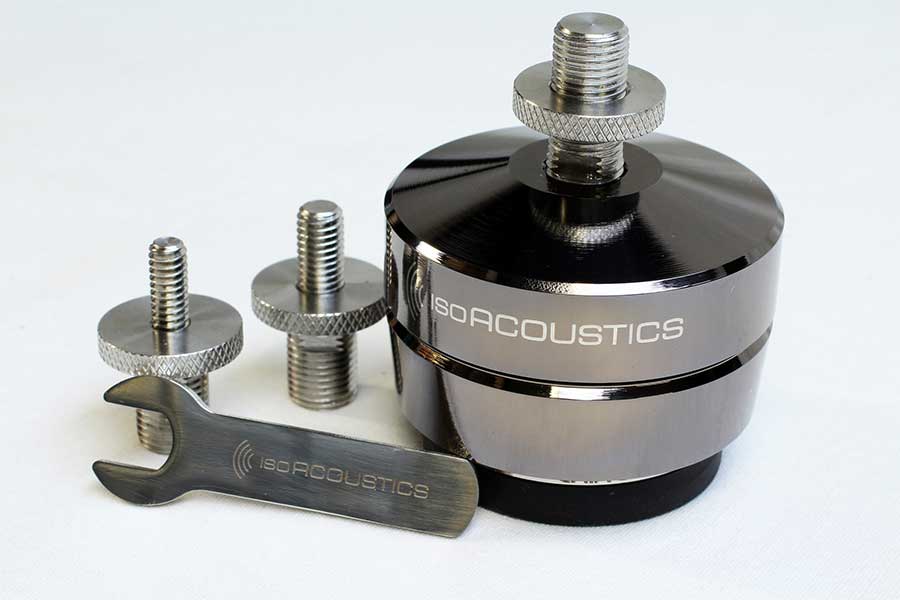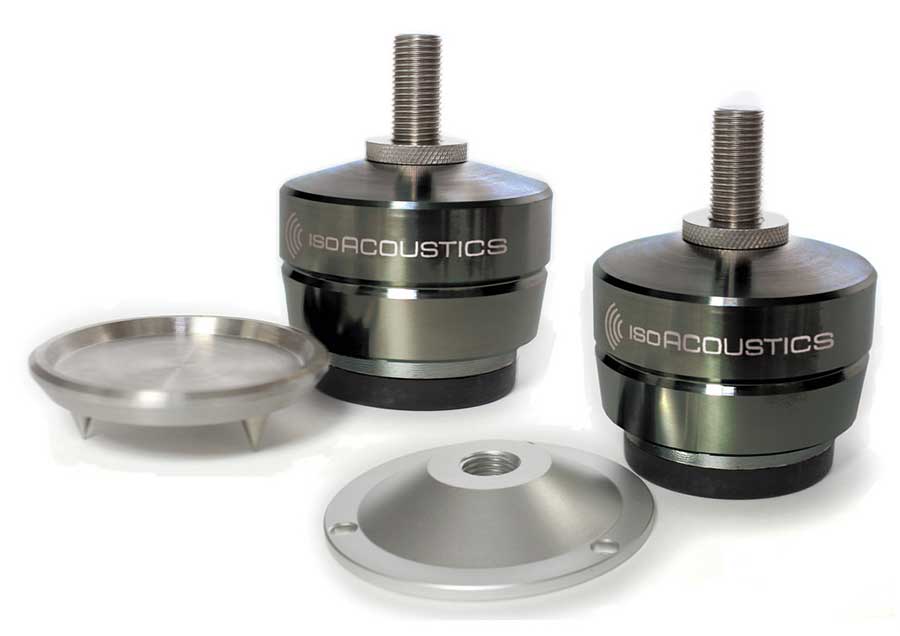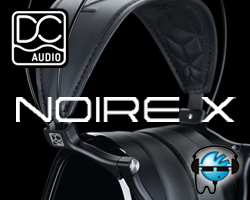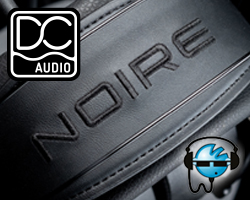Dan Worth takes a look at an interesting tweak from IsoAcoustics in the form of their GAIA III isolation footers costing £199.
This years Bristol Sound and Vision Show has been covered extensively here on Hifi Pig, so take a look at the articles. There were a great number of exhibitors with some really interesting new equipment for 2017.
Among the manufacturers and distributors present I found one of the better sounds and demos to be in the SCV Distribution room, comprising of a range of brands and platforms. For me my interest was directed towards their main show system, which comprised of a Benchmark DAC3 HGC (reviewed here), paired with a Benchmark AHB2 stereo power amplifier and Aria 936 loudspeakers. The characteristics of the sound in this room suited my own personal tastes very well, with a greatly open, full bodied and detailed sound that excels on transparency and insight.
The system demo was very much orientated around what IsoAcoustics GAIA feet, particularly the GAIA III due to its support in weight relation of the Arias, with a 32kg max load capacity. IsoAcoustics also produce two other sizes and weight bearing load versions of the Gaia – the GAIA I which can handle speaker or rack loads up to 100kgs, GAIA II 54kgs and then the Gaia III 32kgs, each rating is per set of four not the individual footer. 
Design wise, aesthetically they are very nice with a high grade stainless steel body which is dark chrome plated and looks fantastic and in combination with the rubberised internal structure which is formed to stabilise internal reflections and also forms as the stable base to the footer in one moulded piece; a tactile suction type force for a hard surface, minimising vibrations and ringing from cabinet to floor and vice versa, allowing the supported speaker to be in a more “floaty” position. Carpet spike adapters are also available for under this system and are not a replacement to the rubberised bottoms which are intrinsically part of the overall vibration control system.
Note: The IsoAcoustic logo on the GAIA needs to be facing forward when the footers are installed due to the lateral movement of the system, alternatively they can be rotated to 180 degrees for a logo-less look.
A standard spike fitted to the bottom of a loudspeaker will transfer energy into any floor, but whether concrete or floating there is still a bounce and a ringing effect. These vibrations will also travel up through the equipment rack and harm the performance of those delicate electronics. Bass energy in a room is also detrimental to speaker performance and the transfer of this energy to the floor and room will reflect back into the speaker causing a smearing effect, especially of the bass leading to overblown and bloaty bass notes. The construction of the GAIA feet disperses and minimises this reaction through the combination of their materials and the movement of the devices to compensate for driver movements during playback, in relation to Newton’s third law.
Installation is a breeze and IsoAcoustics, instead of selling the customer a designated size for their requirements, include 8mm, 6mm and 1/4″ threaded inserts as standard which all fit the GAIA without adapters. Also included is a small wrench for a groove on the threaded inserts for fine adjustments, along with different sized knurled ring fasteners/washers for the underside of the speaker and top of the foot (covering the adjustment groove for complete anal aesthetics) for secure and stable fixing. When installed the speaker becomes flexible to the floor and I spent quite a few childish moments flexing the speaker backwards and forwards like a skyscraper during an earthquake.
The Sound
Personally I’ve been working my way through a bunch of speaker isolators over the past year or so, finding many to either suck out the bass, muddy the midrange or make the sound hard, I was considering trying some Townsend Podiums next but they are really quite expensive. After hearing the GAIAs at Bristol on a system that suited my tastes very well and the A/Bing between two sets of the same speakers, one with the GAIA III and the other pair with standard spikes I thought, now these seem worth investigating further and I’m very glad I did. 
The first most noticeable difference for me when I finished installing the GAIA III was how much more “freer” the sound was from the speakers, the bass especially instantly stood out, far more insight and detailed. Bass extension was far better controlled and tighter with the upper regions being more defined and natural in presentation. My system is hardly lumpy or bloated, but a more explorative and musical nature came with seemingly more weight as the bass was almost able to breath more and felt so much less restrictive in how it interacted with me and my room. Even the nasty node I get in one corner by an alcove disappeared considerably.
Midrange sounds gained a little fluidity and the vocalists had better air and space around them allowing for finer venue acoustics to come through from the recorded material. The overall transparency of the midrange was wonderful with more perceived structure to depth and overall three dimensionality front to back. A particularly welcomed aspect of the speaker being isolated so well was how much grunt and body a male vocalist delivered, with a real throaty and or chesty nature to some artists which is conveyed well here already, but just not quite as good as with the GAIA III in place.
Top end frequencies were also very pleased to receive some GAIA treatment; again the overall air and perceivable bandwidth was extended further to convey more realism and welcomed spatial awareness. Micro details were dynamically stronger and there was a more holographic presentation to boot. Leading edges were also more precise and the cleaner edges were coupled with great tonality and timbre – there is NO loss of body to the upper frequencies although the characteristics were of a cleaner nature. Everything was just more natural, precise and ultimately timed far better.
Overall soundstage presence was more accurate, transparent and spatial, very cohesive and exploratory. One very important factor I will note that has been a bug bearer for me in my listening room is slightly behind me in the upper right part of my room I have always noticed a small null. I can hear harmonics all around my room (and it’s not perfect by any means but what it is is realistic to many domestic setups), apart from this one small area where sound seems to fall into a black hole, after listening to my speakers on the GAIAs I actually was amazed that there was actually sounds in this area and whatever room/speaker/frequency interactions had disturbed things was cured!
Conclusion
If I had to describe the IsoAcoustics GAIA III in one sentence it would be that they allow the speakers to sound more tactile, resolute, spacious and natural, adding tone and timbre and increasing timing performance.
The aesthetically pleasing design, full fixture kit for any speaker (including B&W 800 and Nautilus adapters – optional) and the fact that they stabilise the speakers to the floor so much better than anything else I’ve tried, gives complete peace of mind, especially for the domestic family room, where other anomalies cannot be treated and the speakers are also protected from little fellas who bump into them with their fire engines, they simply flex rather than fall on the micro Firefighters.
I will be buying these two sets for my Ayons and consider these one of the better tweaks I’ve made to the system, I can see the IsoAcoustics GAIA isolation feet doing incredibly well over this side of the pond and I’d like to give credit to SCV Distribution for focusing so intently on their implementation in the demo room at the Bristol Show this year, as they are one of the cheaper products they support and usually it’s the most expensive pieces that are given the limelight at such events.
Build Quality: Superb!
Sound Quality: superb!
Value For Money: Superb!
Pros:
Beautifully constructed, super supportive and allow for the speaker to present itself with far more tactile freedom in bandwidth and allowing the frequencies to really breath, giving more insight, timbre and timing.
Cons:
Absolutely nothing!
Price:
GAIA III (Tested here) – £199
GAIA II – £299
GAIA I – £599
Dan Worth















































































































































































You must be logged in to leave a reply.